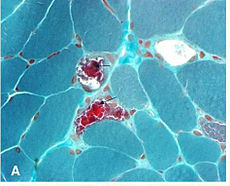- MERRF syndrome
-
MERRF syndrome Classification and external resources 
Example of "ragged red fibers" in MELAS syndrome.ICD-10 G31.8 ICD-9 277.87 OMIM 545000 DiseasesDB 30794 MeSH D017243 MERRF syndrome (or Myoclonic Epilepsy with Ragged Red Fibers) is a mitochondrial disease. It is extremely rare, with an estimated prevalence of 1/400,000 in Europe, and has varying degrees of expressivity owing to heteroplasmy[1]
Contents
Presentation
It involves the following characteristics:
- progressive myoclonic epilepsy
- "Ragged Red Fibers" - clumps of diseased mitochondria accumulate in the subsarcolemmal region of the muscle fiber and appear as "Ragged Red Fibers" when muscle is stained with modified Gömöri trichrome stain
- short stature
- hearing loss
- lactic acidosis
- exercise intolerance
- poor night vision
Causes
The MERRF syndrome is caused by a maternally-inherited mutation at position 8344 in the mitochondrial genome in over 80% of cases. This point mutation disrupts the mitochondrial gene for tRNA-Lys and so disrupts synthesis of proteins essential for oxidative phosphorylation.
Many genes are involved.[2] These include:
- MT-TK[3]
- MT-TS1[5]
- MT-TS2
- MT-TF[6]
Treatment
Like many mitochondrial diseases, there is no cure for MERRF and treatment is primarily symptomatic. High doses of Coenzyme Q10 and L-Carnitine have been tried with little success as therapies in hopes of improving mitochondrial function.[7]
See also
References
- ^ Gene Reviews- MERRF
- ^ Online 'Mendelian Inheritance in Man' (OMIM) MYOCLONIC EPILEPSY ASSOCIATED WITH RAGGED-RED FIBERS; MERRF -545000
- ^ Zeviani M, Muntoni F, Savarese N, et al. (1993). "A MERRF/MELAS overlap syndrome associated with a new point mutation in the mitochondrial DNA tRNA(Lys) gene". Eur. J. Hum. Genet. 1 (1): 80–7. PMID 8069654.
- ^ Melone MA, Tessa A, Petrini S, et al. (February 2004). "Revelation of a new mitochondrial DNA mutation (G12147A) in a MELAS/MERFF phenotype". Arch. Neurol. 61 (2): 269–72. doi:10.1001/archneur.61.2.269. PMID 14967777. http://archneur.ama-assn.org/cgi/pmidlookup?view=long&pmid=14967777.
- ^ Nakamura M, Nakano S, Goto Y, et al. (September 1995). "A novel point mutation in the mitochondrial tRNA(Ser(UCN)) gene detected in a family with MERRF/MELAS overlap syndrome". Biochem. Biophys. Res. Commun. 214 (1): 86–93. doi:10.1006/bbrc.1995.2260. PMID 7669057. http://linkinghub.elsevier.com/retrieve/pii/S0006-291X(85)72260-7.
- ^ Mancuso M, Filosto M, Mootha VK, et al. (June 2004). "A novel mitochondrial tRNAPhe mutation causes MERRF syndrome". Neurology 62 (11): 2119–21. PMID 15184630. http://www.neurology.org/cgi/pmidlookup?view=long&pmid=15184630.
- ^ Gene reviews - MERRF. Management of patients
External links
- MeSH MERRF+Syndrome
- -214630359 at GPnotebook
- merrf at NIH/UW GeneTests
Non-Mendelian inheritance: Mitochondrial diseases (277.87) Carbohydrate metabolism Primarily nervous system Myopathies No primary system Chromosomal Seizures and epilepsy (G40–G41, 345) Basics Seizure types · Seizure trigger · Breakthrough seizure · Postictal state · Epileptogenesis · Seizure prediction · Aura (warning sign)Treatments Antiepileptics · Template:Anticonvulsants (for list) · Electroencephalography (diagnosis method) · EpileptologistRelated disorders Epilepsy organizations Epilepsy Foundation (USA) · International Dravet Epilepsy Action League · Epilepsy Toronto · Epilepsy Research UK · Epilepsy Action Australia · Citizens United for Research in Epilepsy · Epilepsy Action · Epilepsy SocietyIssues for epileptics Seizure types
Epilepsy typesPartial/focal Seizures: Simple partial · Complex partial · Jacksonian seizure
Epilepsy: Temporal lobe epilepsy · Frontal lobe epilepsy · Rolandic epilepsy · Nocturnal epilepsyGeneralised Tonic-clonic · Absence seizure · Atonic seizure · Automatism · Benign familial neonatal · Lennox-Gastaut · WestStatus epilepticus Myoclonic epilepsy Non-epileptic seizures Categories:- Mitochondrial diseases
- Myoneural junction and neuromuscular diseases
- Rare diseases
- Genetic disorder stubs
Wikimedia Foundation. 2010.
